
T rue ihsas is possible at every performance because the munshid is a true Sufi believer. When he sings the words that describe his beliefs, the feeling always flows spontaneously from him. The munshid’s music is thus always an aesthetic expression of an authentic mystical condition. But the secular musician is more like an actor. At best, feeling may be artificially and temporarily synthesized to support expression, but even this much cannot be guaranteed since there is no special belief system available to assure the correlation of the music with feeling.”DSM: There was an interesting remark that Sandy Yamamoto of the Miró Quartet made the other day, about how she enters into her part—about how she prepares herself before the Miró Quartet commences performing a piece. She was, I think, basically describing a sort of ‘sense memory’ for the character of the piece—or, more precisely, a ‘sense memory’ for the character of her part.
— Michael Frishkopf, Tarab in the Mystic Sufi Chant, in Colors of Enchantment: Visual and Performing Arts of the Middle East, Sherifa Zuhur, ed. American Univ Cairo Press, 2001.
CMT: I think the performer has a duty to enter into the mind of the composer, to “get into character” for a piece—just like an actor. While interpreting the piece, the performer imagines the feelings of the composer, and responds and reacts to the expressions of the other performers—or even the atmospherics of the audience—in the context of her/his own experiences.
DSM: In the Nineteenth Century and the Romantic period, the sense of being authentic or ‘true’ to a work was so much about being true to the composer’s emotional content, which the artist was obliged to render accurately and faithfully. In the Eighteenth Century and earlier, the notion of authenticity allowed more scope to the performer. But in every era, being true to the emotions leads performing artists to take liberties with the text—take liberties with the notation on the page. The rationale that’s offered by those who choose this approach is generally that the musical text is something that can and must be modified as part of the performer’s role in a performance, much like an actor or director suggests or requests a line change to stay more true to a character.
CMT: There was a strong reaction against this in the late Twentieth Century, of course—a trend toward “authentic-qua-textually-fastidious” performances, using period instruments that made it possible to hear the works as they might originally have been performed. I suppose that’s part of the milieu of historically correct Civil War reenactments these days, the Society for Creative Anachronism, Massively Multi-Player computer gaming, and so on. But if you have hundreds or thousands of actors as in re-enactments or Massively Multi-Player gaming, the concept of adherence to a text breaks down. Overall, you get expressive dyssynchrony, incontinence. And yet each of the players/actors is locally continent and consonant with the performances rendered in his/her area, in his/her locale. You have a confederation of artistically expressive nomads and nomadic cliques, in Deleuze’s sense.
DSM: Well, it’s an artifact of western music history that the composer’s emotional conception of the work often dominates our thinking. The western myth is:
composer’s emotions → as-composed expressions → textually literal practice performance → intended emotion elicited in audience members.
But in fact the causal chain of events is more this way:
composer’s emotions → as-composed expressions → studying score/rehearsing → emotions elicited in performer different from composer’s emotions → performer’s understanding of the work’s meaning and creative ideas for expressing those ideas through the performance → refinement of concept, including input from critics and theorists → practice performance, with adjustments to create emotionally authenticity → intended emotion elicited in audience members.
The classical musics of non-western cultures are hardly so composer-centric—Indian and Asian and Middle Eastern music, for example.
CMT: And your arrows are re-instantiated and can change substantially from performance to performance by the same performer. They can be dramatically different from performer to performer. The big mistake in western music theory and western performance practice is supposing that there is a complete, finished work that existed in the composer’s imagination and is totally and unambiguously specified by the score and its annotations. No one would make such a mistake in theatre. One true and authentic Hamlet only? Preposterous!
DSM: You have to invest yourself in the dynamic of each rehearsal. You have to understand that your fellow ensemble members need to do many preparative things before they get to the point where they are ready to get themselves into character and immerse themselves in the piece in front of them.
CMT: And how different that warming-up and tuning and other pre-preparation is for a pianist than for string players or wind instruments. How different it is even among different instruments within a family! So each performer has to keep quiet, be patient with the others, and each has to observe and understand what’s going on—has to gauge what remains for the others to finish doing before they can get their ‘game face’ fully “on”.
DSM: One thing a composer learns is that, in general, musicians aren’t too interested in why they’re doing what they’re doing. All they want to know is: What do I need to do? When do I need to do it? For many performers, if you start to try to explain the meaning or intent behind the composition, their eyes glaze over. It’s interesting that theater’s the exact opposite of this. A good actor or actress won’t do anything until they’ve understood everything. The insist on knowing about the playwright’s motivation, about his/her intended nuances and connection of the lines, about the characters psyches and personal histories, and so on. By contrast, the average musician isn’t very interested in this. The great musician, though, tries to inhabit her/his part, much like an actor would do. You don’t have to be an opera singer for this to matter. It’s equally important for instrumentalists to conceive of who the character is whose voice they play in a piece. They need to inhabit that character in performance, to deliver an authentic and compelling performance.
CMT: Are you implying that musicians also need to adopt some specific framework for their acting—like “sense memory” in method acting, for example?
I t does not matter so much what the actor thinks, but the fact that he is really thinking something that is real to him at that particular moment. The make-believe thinking that may coincide with the play is not real enough.”
— Lee Strasberg, ‘A Dream of Passion’
DSM: Well, yes. One of Strasberg’s reasons for personalizing the actor’s imagination in getting into character was to enhance the realism. According to Strasberg, the actor needs to include in preparation some specific objects from her/his own personal life, reacting to those familiar personal objects rather than the set or props of the play. In discussing the use of “sense memory”, he emphasized that it wasn’t enough for the actor to attend to memories in an abstract way. Only by means of a concrete sensory binding to these personal objects can the emotions be reliably evoked. It’s not enough to say, “It was really hot.” Instead, the actor must define how she/he experienced a particular heat remembered from her/his own life. By deliberately recalling a sensual memory, the actor reacts to the internal object, and that then becomes the foundation for a very realistic performance. You must “really think something that’s real.” You’ve got to hold that in your mind, as an anchor for what you do with the text. If successful, the emotionality impresses the audience by virtue of its realism—the realism is supposedly greater because those actual objects from the actor’s own life are what’ve invoked it.
CMT: But the undesirable side-effect of method acting—criticized by Joseph Chaikin and others—is that, in order to inhabit the character, the method actor involves himself with the character’s inner dilemma. “But the character,” Chaikin says, “if he were a living person, would be doing the opposite—trying to relieve himself of his unhappiness, and trying to respond to the circumstances around him.” Chaikin deplores the way that the “eyes of this actor are always secretly looking into his own head.”
DSM: By contrast, the psychological realism of early naturalism relies on imagery derived from analysis of the text itself. Necessary to drive realism into the performance, the “inner image”, according to Konstantin Stanislavsky, is text-based ‘make-believe’ rather than referencing an actual personal object. But even though this may be less intense and more detached, it still lends character and nuance to the delivery of the lines. I think more musicians are closer to Stanislavsky in their performance practice than they are to Strasberg, don’t you?
CMT: Maybe. But, either way, in order to inflect the individual parts of a speech with different emotional nuances, it’s helpful to the actor/musician to be able to shift among the inner images in a carefully planned order or sequence. How detailed you have to be depends on the motivic complexity and length of the piece. This is true regardless whether you’re a method actor or following Stanislavsky’s or some other approach. The method of blending role and personal experiences is valuable—maybe it’s inevitable.

DSM: You can over-do this, though—this blending of personal life and role. Even Strasberg advocated other training techniques such as improvisation to “stimulate a continuous flow of response and thought within the actor,” balancing the tendency to be “looking into one’s own head.” He wasn’t a ‘method bigot’.
CMT: So the technique of adding realism by psychologically motivating the performance in personal terms—rather than a Stanislavskian, text-derived motivation—has various alternatives. One was recently recounted by Lindsay Crouse in discussing her testimony in Sidney Lumet’s ‘The Trial’. She imagined that the act of giving testimony was a confession directed at personal life and that such a confession was instrumental in enabling her to move on. The instrumentality of the confession in enabling her character to ‘move on’ in her life was the conceit that powered Lindsay’s highly authentic, realistic testimony performance.
DSM: Yes. And in Casablanca, Bogart probably ferried some of his marital problems into his role. In his film noir roles he may’ve brought some of his disillusionment with Hollywood. It’s hard to imagine how he could’ve totally ‘checked that at the door’ at any rate.
CMT: More than the infeasibility of completely compartmentalizing and distancing our concrete personal lives, it’s hard to see how an abstract entity such as a character’s ‘personality’ can be brought into the imaginative work in order to achieve the performance we want. It’s likely that concrete and highly personal objects inevitably affect our creative performance. Better to arrange it deliberately instead of allowing it to be happenstantial. The deliberate incorporation of concrete personal references helps us to manage what would otherwise be glaring contradictions—belying the fractured assumption of one coherent, simplistic personality. If we take the concept of auteur to refer to those un-simple aesthetic properties that are essential in a composition’s overall design, we’re able to acknowledge a chamber musician’s actorly contribution to the collective creative enterprise of the ensemble. But rather than taking the premise of a controlling will or one coherent composerly intellect for the work, the performers and listeners should look for what’s most valuable in the work—should look for what elements embody most of the meaning. That still leaves plenty of room for discovery and for spontaneous, dynamic interpretations. It still leaves plenty of room for nuance and surprise.
DSM: These aspects remind me of Deleuze’s writing on music vs. Adorno’s writing. Deleuze: the theorist of immanence and dynamic ‘becoming-music’ and univocality of being. Adorno: the theorist of irreducible contradictions and static plurality and structural multivocal conflict.
T o improvise is to join with the world, meld with it.”
— Gilles Deleuze & Felix Guattari, ‘A Thousand Plateaus’, 1987, p. 311
CMT: Very tactile, very multi-sensory, very kinesthetic—‘haptic’, to use Deleuze’s fancy word. Deleuze allows for both a haptic act of seeing and a haptic act of listening. Haptic vision is a mode of seeing that, from the artist’s easel, summons not just the eye but the ear and the touch. Haptic listening is a mode of hearing that, from the performer’s instrument, summons not just the ear but the eye and the touch. The senses aren’t alienated from each other, they’re intertwined. This inter-relation and interchangeability and cross-talk among the senses was part of what Sandy Yamamoto was implying by her comments the other night, I think. You compose the sounds; you imagine them in advance of your attacking the first note. Authentic music performance in this way becomes a wholistic composing of the senses—like an actor’s multi-sensory composite performance. No matter how many times you’ve performed the work before, you must imagine the senses again, compose the senses again.

- Method Acting for Directors website
- TheatrGROUP website
- Bachelard G. Air and Dreams: An Essay on the Imagination of Movement. Dallas Inst, 1988.
- Bachelard G. The Poetics of Space. Beacon, 1976.
- Bachelard G. The Poetics of Reverie. Orion, 1969.
- Batson S. Truth: Personas, Needs, and Flaws in the Art of Building Actors and Creating Characters. Rugged Land, 2007.
- Baudrillard J. The Vital Illusion. Columbia Univ, 2001.
- Bial H. The Performance Studies Reader. Routledge, 2003.
- Brandon M. Winning Auditions: 101 Strategies for Actors. Limelight, 2005.
- Buchanan I, Swiboda M. Deleuze and Music. Univ Edinburgh, 2004.
- Cohen R. Advanced Acting: Style, Character, and Performance. McGraw-Hill, 2001.
- Cook O. Singing with Your Own Voice. Nick Hern, 2004.
- Cox M, Theilgaard A. Shaekspeare as Prompter: The Amending Imagination. Jessica Kingsley, 1995.
- Craig D. A Performer Prepares: A Guide to Song Preparation for Actors, Singers, and Dancers. Applause, 2000.
- Davis T, Postlewait T, eds. Theatricality. Cambridge Univ, 2004.
- Deleuze G, Guattari F. A Thousand Plateaus. Univ Minnesota, 1987.
- Dolan J. Utopia in Performance: Finding Hope at the Theater. Univ Michigan, 2005.
- Easty E. On Method Acting. Ivy, 1989.
- Evenden M. Silence and Selfhood: Desire of Order in Mozart's Magic Flute. Peter Lang, 1999.
- Gane N. Max Weber and Postmodern Theory: Rationalisation vs. Re-Enchantment. Palgrave Macmillan, 2003.
- Gorchakov N. Stanislavsky Directs. Greenwood, 1974.
- Hagen U, Frankel H. Respect for Acting. Wiley, 1973.
- Hong-Young A. Singing Professionally. Heinemann, 2003.
- Howey B. The Actor's Menu: A Character Preparation Handbook. Compass, 2005.
- Hull S. Strasberg's Method: A Practical Guide for Actors, Teachers, Directors. Hull-Smithers, 2004.
- Jackson S. Professing Performance: Theatre in the Academy from Philology to Performativity. Cambridge Univ, 2004.
- Kayes G. Singing and the Actor. Routledge, 2000.
- Kershaw B. The Politics of Performance. Taylor & Francis, 2005.
- Kershaw B. The Radical in Performance: Between Brecht and Baudrillard. Routledge, 1999.
- Knowles R. Reading the Material Theatre. Cambridge Univ, 2004.
- Kronegger M, Tymieniecka A, eds. The Aesthetics of Enchantment in the Fine Arts. Springer, 2006.
- Levin I, Levin I. Working on the Play and the Role: The Stanislavsky Method for Analyzing the Characters in Drama. Dee, 1990.
- Meisner S. Sanford Meisner on Acting. Vintage, 1987.
- Morris E. Acting, Imaging, and the Unconscious. Ermor, 1998.
- Morris E. Acting from the Ultimate Unconscious. Ermor, 1992.
- Morris E. Irreverent Acting. Ermor, 1992.
- Morris E. Being and Doing: A Workbook for Actors. Ermor, 1990.
- Ostwald D. Acting for Singers: Creating Believable Singing Characters. Oxford Univ, 2005.
- Pinney C, Thomas N, eds. Beyond Aesthetics: Art and the Technologies of Enchantment. Berg, 2001.
- Pitches J. Science and the Stanislavsky Tradition of Acting. Routledge, 2005.
- Potter N, ed. Movement for Actors. Allworth, 2002.
- Powell J. Music and Theatre in France, 1600-1680. Oxford Univ, 2000.
- Schechner R. Performance Theory. Routledge, 2003.
- Schechner R. Performance Studies: An Introduction. Routledge, 2002.
- Strasberg L. A Dream of Passion: The Development of the Method. Plume, 1988.
- Turner V. The Anthropology of Performance. PAJ, 1986.
- Wangh S. An Acrobat of the Heart: Physical Approach to Acting. Vintage, 2000.
- Yakim M, Broadman M. Creating a Character: A Physical Approach to Acting. Applause, 2000.
- Eric Edberg at DePauw University
- Ben Brantley review of David Hare’s ‘The Vertical Hour’, NY Times
- Charles McNulty review of David Hare’s ‘The Vertical Hour’, LA Times
- Society for Creative Anachronism website
- Actor Training, Drama Division, Juilliard School
- AmericanDrama.org
- Eric Morris Actors Workshop
- Stella Adler Actors Workshop
- Actor Training, American Conservatory Theater
- The Actors Institute

No comments:
Post a Comment